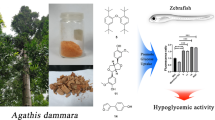Abstract
Twenty-nine free and glucosylated dihydrophenanthrenes and tetrahydropyrenes isolated fromJuncus effusus have been tested against the unicellular green algaSelenastrum capricornutum. The free compounds showed a strong inhibitory activity, while the glucosides were inactive or had a slight stimulating effect on growth. Tetrahydropyrene33, obtained by hydrolysis of the naturalβ-glucosides29 and30 or by hemisynthesis from1, is the most active compound, causing 90% inhibition of the growth at 2.5 × 10−5 M concentration. Synthetic α-glucosides28, 31, and32 showed comparable activity to those of29 and30.
Similar content being viewed by others
References
Aliotta, G., Della Greca, M., Monaco, P., Pinto, G. Pollio, A., andPrevitera, L. 1990. In vitro algal growth inhibition by phytotoxins ofTypha latifolia L.J. Chem. Ecol. 16:2637–2646.
Aliotta, G., Monaco, P., Pinto, G., Pollio, A., andPrevitera, L. 1991. Potential allelochemicals fromPistia stratiotes L.J. Chem. Ecol. 17:2223–2234.
Aliotta, G., Della Greca, M., Monaco, P., Pinto, G., Pollio, A., andPrevitera, L. 1995. Potential allelochemicals from aquatic weeds: their action on microalgae.Allelopathy J. 2:37–48.
Anderson, L. W. J., andDechoretz, N. 1984. Laboratory and field investigations of a potential selective algicide, PH 4062.J. Aquat. Plant Manage. 22:67–75.
Andrews, J. 1986. Nuisance vegetation in the Madison lakes: Current status and options for control. Committee Report, University of Wisconsin, Madison. 196 pp.
Blankley, W. F. 1973. Toxic and inhibitory materials associated with culturing, pp. 207–223,in J. R. Stein (ed.). Handbook of Phycological Methods. Cambridge University Press, Cambridge.
Canale, R. P., andAuer, M. T. 1982. Ecological studies and mathematical modeling ofCladophora in Lake Huron. V. Model development and calibration.J. Great Lakes Res. 8:112–125.
Carmichael, W. W. 1986. Algal toxins.Adv. Bot. Res. 12:47–101.
De Alvarenga, M. A., andGottlieb, O. R. 1974. Methyl-and methylthio-phenanthrenes fromMicrandropsis scleroxylon.Phytochemistry 13:1283–1288.
Della Greca, M., Fiorentino, A., Mangoni, L., Molinaro, A., Monaco, P., andPrevitera, L. 1992. 9,10-Dihydrophenanthrenes metabolites fromJuncus effusus L.Tetrahedron Lett. 33:5257–5260.
Della Greca, M., Fiorentino, A., Mangoni, L., Molinaro, A., Monaco, P., andPrevitera, L. 1993. Cytotoxic 9,10-dihydrophenanthrenes fromJuncus effusus L.Tetrahedron 49:3425–3432.
Della Greca, M., Fiorentino, A., L., Molinaro, A., Monaco, P., andPrevitera, L. 1995a. 9,10-Dihydrophenanthrene glucosides fromJuncus effusus L.Nat. Prod Lett. 6:111–117.
Della Greca, M., Fiorentino, A., Monaco, P., Previtera, L., andZarrelli, A. 1995b. Effusides I–V: 9,10-Dihydrophenanthrene fromJuncus effusus L.Phytochemistry 40:533–535.
Della Greca, M., Fiorentino, A., Monaco, P., Previtera, L., andZarrelli, A. 1995c. Tetrahydropyrene glucosides inJuncus effusus L.Nat. Prod. Lett. 7:85–92.
Della Greca, M., Monaco, P., Pinto, G., Pollio, A., andPrevitera, L. 1995d. Mimics of natural phenylpropanoids—in vitro antialgal activity.Allelopathy J. 2:37–48.
Elder, J. F., andHorne, A. J. 1978. Copper cycles and CuSO4 algicidal capacity in two California lakes.Environ. Manag. 2:17–30.
Elliot, L. F., andCheng, H. H. 1985. Assessment of allelopathy among microbes and plants, pp. 504–515,in G. R. Waller (ed.). Allelochemicals, Role in Agriculture and Forestry. American Chemical Society, Washington, D.C.
Hansen, G. W., Oliver, F. E., andOtto, N. E. 1984. Herbicide Manual. U.S. Department of Interior, Bureau of Reclamation, Denver, Colorado. 346 pp.
Harborne, J. B. 1977. Introduction to Ecological Biochemistry. Academic Press, London, U.K.
Lembi, C. A., O'Neal, S. W., andSpencer, D. F. 1988. Algae as weeds: Economic impact, ecology, and management alternatives, pp. 455–481,in C. A. Lembi and J. R. Waaland (eds.). Algae and Human Affairs. Cambridge University Press, Cambridge.
Miles, D. H., Randle, S., Shakir, R., andAtwood, J. L. 1981. Structure of juncunone: A biogenetically intringuing molecule from the marsh plantJuncus roemerianus.J. Org. Chem. 46:2813–2816.
Milne, A., andCallow, M. E. 1985. Non-biocidal antifouling processes, pp. 229–233,in R. Smith (ed.). Polymers in a Marine Environment. Institute of Marine Engineers, London.
McKnight, D. 1981. Chemical and biological processes controlling the response of a freshwater ecosystem to copper stress: A field study of the CuSO4 treatment of Mill Pond Reservoir, Burlington, Massachusetts.Limnol. Oceanogr. 26:518–531.
Nichols, H. W. 1973. Growth media-freshwater, pp. 7–24,in J. R. Stein (ed.). Handbook of Phycological Methods. Cambridge University Press, Cambridge.
Pinto, G., Pollio, A., Della Greca, M., andLigrone, R. 1995. Linoleic acid as a potential allelochemical released byEichhornia crassipes (Mart.) Solms in a continuous trapping apparatus.Allelopathy J. 2:169–178.
Pipe, A. E., andShubert, L. E. 1984. Algae as Ecological Indicators. Academic Press, London.
Pollio, A., Pinto, G., Ligrone, R., andAliotta, G. 1993. Effects of the potential allelochemical α-asarone on growth, physiology and ultrastructure of two unicellular green algae.J. Appl. Phycol. 5:395–403.
Sarkar, H., Zerezghi, M., andBhattacharyya, J. 1988. Dehydrojuncusol, a constituent of the roots ofJuncus roemerianus.Phytochemistry 27:3006–3008.
Shima, K., Toyota, M., andAsakawa, J. 1991. Phenanthrene derivatives from the medullae ofJuncus effusus.Phytochemistry 30:3149–3151.
Steidinger, K. A., andBaden, D. G. 1984. Toxic marine dinoflagellates, pp. 201–261,in L. Spector (ed.). Dinoflagellates. Academic Press, New York.
Author information
Authors and Affiliations
Rights and permissions
About this article
Cite this article
Greca, M.D., Fiorentino, A., Monaco, P. et al. Action of antialgal compounds fromJuncus effusus L. onSelenastrum capricornutum . J Chem Ecol 22, 587–603 (1996). https://doi.org/10.1007/BF02033657
Received:
Accepted:
Issue Date:
DOI: https://doi.org/10.1007/BF02033657




